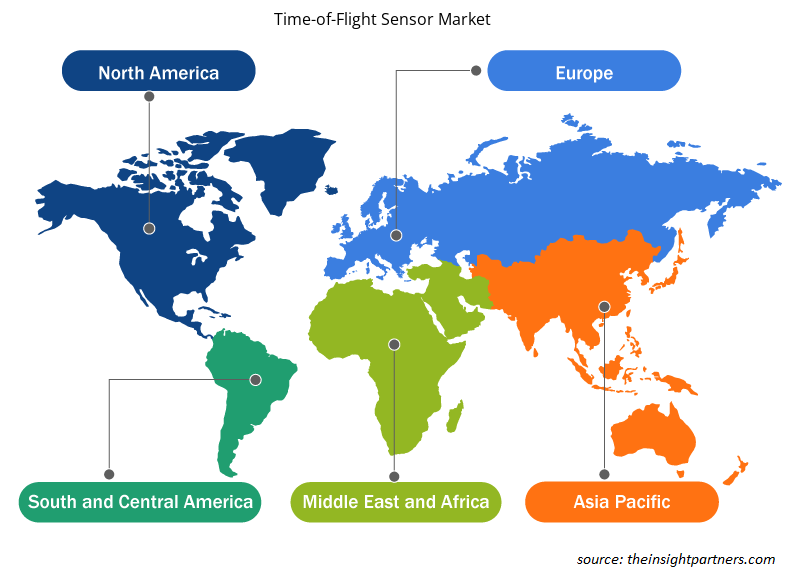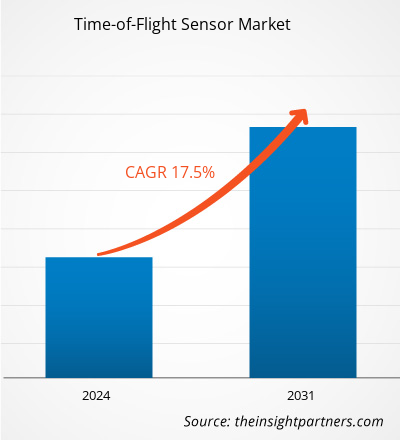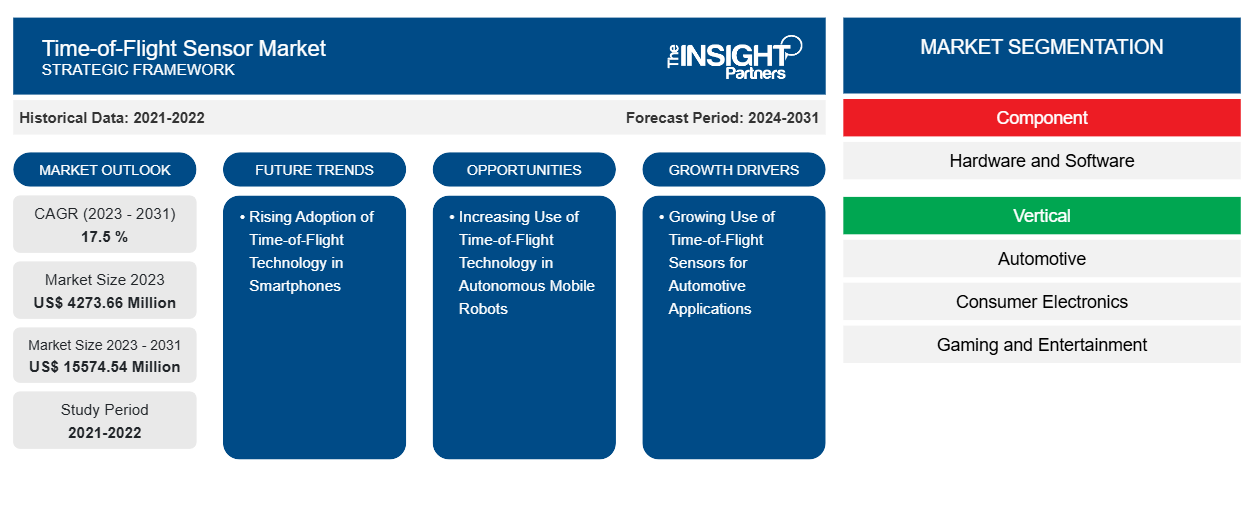Der Markt für Time-of-Flight-Sensoren soll von 4.273,66 Millionen US-Dollar im Jahr 2023 auf 15.574,54 Millionen US-Dollar im Jahr 2031 anwachsen. Der Markt soll zwischen 2023 und 2031 eine durchschnittliche jährliche Wachstumsrate (CAGR) von 17,5 % verzeichnen. Die zunehmende Verbreitung der Time-of-Flight-Technologie in Smartphones dürfte ein wichtiger Trend auf dem Markt bleiben.
Marktanalyse für Time-of-Flight-Sensoren
Die Nachfrage nach ToF-Sensoren steigt aufgrund ihrer zunehmenden Verwendung in der Automobilindustrie. Die Technologie wird verwendet, um das Verhalten des Fahrers zu überwachen, was dazu beiträgt, Verkehrsunfälle zu verhindern und die Fahrzeugsicherheit zu verbessern. Darüber hinaus steigt die Nachfrage nach den Sensoren in anderen Branchen wie Unterhaltungselektronik, Gesundheitswesen, Gaming und Unterhaltung sowie Luft- und Raumfahrt und Verteidigung. Infolgedessen entwickeln die Marktteilnehmer fortschrittliche ToF-Sensoren. Im Februar 2020 gab die Panasonic Corporation bekannt, dass sie einen Time-of-Flight-Bildsensor entwickelt hat, der Avalanche-Photodioden-Pixel (APD) verwendet. Er kann hochpräzise 3D-Informationen entsprechend der Position von Objekten aus nahen bis zu fernen Entfernungen von bis zu 250 m erfassen. Diese Sensoren können in verschiedenen Bereichen eingesetzt werden, beispielsweise bei der Entfernungsbildgebung von Kraftfahrzeugen und der Großflächenüberwachung.
Marktübersicht für Time-of-Flight-Sensoren
Time-of-Flight-Sensoren (ToF) werden verwendet, um die Zeit zu messen, die ein Objekt benötigt, um eine Distanz durch ein Medium zurückzulegen. Sie berechnen die Zeitdifferenz zwischen der Aussendung eines Signals und seiner Rückkehr zum Sensor, nachdem es von einem Objekt reflektiert wurde. Der Sensor wird für verschiedene Anwendungen verwendet, darunter Roboternavigation, Personenzählung, Fahrzeugüberwachung und Objekterkennung. Es handelt sich um ein All-in-One-System für eine kostengünstige, einfache und platzsparende Integration. Es bietet echte Entfernungsmessung, unabhängig von Zielgröße, Farbe und Reflexionsgrad. Darüber hinaus verwenden ToF-Sensoren Laser , um große Entfernungen und Reichweiten mit hoher Präzision zu messen.
Passen Sie diesen Bericht Ihren Anforderungen an
Sie erhalten kostenlos individuelle Anpassungen an jedem Bericht, einschließlich Teilen dieses Berichts oder einer Analyse auf Länderebene, eines Excel-Datenpakets sowie tolle Angebote und Rabatte für Start-ups und Universitäten.
-
Holen Sie sich die wichtigsten Markttrends aus diesem Bericht.Dieses KOSTENLOSE Beispiel umfasst eine Datenanalyse von Markttrends bis hin zu Schätzungen und Prognosen.
Markttreiber und Chancen für Time-of-Flight-Sensoren
Zunehmender Einsatz von Time-of-Flight-Sensoren für Automobilanwendungen
Neben den Entwicklungen in der Fahrzeugsicherheit bietet die ToF-Technologie auch Komfort und Bequemlichkeit im Fahrzeuginnenraum, was Fahrern und Passagieren zugutekommen kann. Die Sitze können verschoben und die Sicherheitsgurte näher herangebracht werden, wenn der Passagier ins Auto steigt. Sie kann dem Fahrer oder Passagier auch helfen, indem sie das Licht der Ablagefächer einschaltet, wenn eine Hand in diese Richtung greift. Somit fördert die zunehmende Verwendung von ToF-Sensoren für Automobilanwendungen das Wachstum des Marktes für Time-of-Flight-Sensoren.
Zunehmender Einsatz der Time-of-Flight-Technologie bei autonomen mobilen Robotern
Im Lagerbetrieb können Time-of-Flight-Kameras überlegene Intelligenz für autonome mobile Roboter (AMRs) und fahrerlose Transportfahrzeuge (AGVs) liefern. Die Kameras können verwendet werden, um die Umgebung zu beobachten und Tiefenbilddaten zu erfassen, was geschäftskritische Funktionen durch Genauigkeit, Komfort und Geschwindigkeit weiter verbessert. Die Kamera verfügt über verschiedene Funktionen wie Lokalisierung, Kartierung, Hindernisvermeidung, Navigation, Objekterkennung und Odometrie. Die Nachfrage nach Time-of-Flight-Kameras steigt, was es den Marktteilnehmern ermöglicht, technologisch fortschrittliche Time-of-Flight-Kameras zu erwerben. Daher schaffen solche Innovationen der Marktteilnehmer und die zunehmende Einführung von Time-of-Flight-Sensoren in AMRs lukrative Möglichkeiten für den Markt für Time-of-Flight-Sensoren.
Segmentierungsanalyse des Marktberichts zum Time-of-Flight-Sensor
Wichtige Segmente, die zur Ableitung der Marktanalyse für Flugzeitsensoren beigetragen haben, sind Gerätetyp und Branche.
- Basierend auf dem Gerätetyp ist der Markt für Time-of-Flight-Sensoren in HF-modulierte Lichtquellen mit Phasendetektoren, bereichsgesteuerte Bildgeber und direkte Time-of-Flight-Bildgeber unterteilt. Das Softwaresegment hatte im Jahr 2023 einen größeren Marktanteil.
- Nach Branchen ist der Markt segmentiert in Automobil, Unterhaltungselektronik, Spiele und Unterhaltung, Industrie, Gesundheitswesen, Luft- und Raumfahrt und Verteidigung, Sonstiges.
Marktanteilsanalyse für Flugzeitsensoren nach geografischer Lage
Der geografische Umfang des Marktberichts zum Time-of-Flight-Sensor ist hauptsächlich in fünf Regionen unterteilt: Nordamerika, Asien-Pazifik, Europa, Naher Osten und Afrika sowie Süd- und Mittelamerika. Der nordamerikanische Markt ist auf die wachsende Nachfrage nach Time-of-Flight-Sensoren (ToF) in Automobil- und Unterhaltungselektronikanwendungen zurückzuführen. Einige der von der ToF-Kamera gebotenen Sicherheitsfunktionen sind die von NCAP vorgeschriebene Fahrermüdigkeitserkennung, Körperhaltung, Blickerkennung, Hände-am-Lenkrad-Erkennung, erweiterte Sicherheitsgurtanwendung und Kopfhaltung. Die Sicherheitsfunktion des Time-of-Flight-Sensors ist bei Verkehrsunfällen von Vorteil. Aufgrund des zunehmenden Bewusstseins für Sicherheitsfunktionen steigt die Nachfrage nach Fahrzeugen mit integrierter ToF-Kamera in der nordamerikanischen Region.
Regionale Einblicke in den Time-of-Flight-Sensor-Markt
Die regionalen Trends und Faktoren, die den Markt für Flugzeitsensoren im Prognosezeitraum beeinflussen, wurden von den Analysten von Insight Partners ausführlich erläutert. In diesem Abschnitt werden auch die Marktsegmente und die Geografie von Flugzeitsensoren in Nordamerika, Europa, im asiatisch-pazifischen Raum, im Nahen Osten und Afrika sowie in Süd- und Mittelamerika erörtert.

- Erhalten Sie regionale Daten zum Markt für Flugzeitsensoren
Umfang des Marktberichts zum Time-of-Flight-Sensor
| Berichtsattribut | Details |
|---|---|
| Marktgröße im Jahr 2023 | 4273,66 Millionen US-Dollar |
| Marktgröße bis 2031 | 15.574,54 Millionen US-Dollar |
| Globale CAGR (2023 - 2031) | 17,5 % |
| Historische Daten | 2021-2022 |
| Prognosezeitraum | 2024–2031 |
| Abgedeckte Segmente |
Nach Komponente
|
| Abgedeckte Regionen und Länder |
Nordamerika
|
| Marktführer und wichtige Unternehmensprofile |
|
Marktteilnehmerdichte für Time-of-Flight-Sensoren: Auswirkungen auf die Geschäftsdynamik verstehen
Der Markt für Time-of-Flight-Sensoren wächst rasant. Dies wird durch die steigende Nachfrage der Endnutzer aufgrund von Faktoren wie sich entwickelnden Verbraucherpräferenzen, technologischen Fortschritten und einem größeren Bewusstsein für die Vorteile des Produkts vorangetrieben. Mit der steigenden Nachfrage erweitern Unternehmen ihr Angebot, entwickeln Innovationen, um die Bedürfnisse der Verbraucher zu erfüllen, und nutzen neue Trends, was das Marktwachstum weiter ankurbelt.
Die Marktteilnehmerdichte bezieht sich auf die Verteilung der Firmen oder Unternehmen, die in einem bestimmten Markt oder einer bestimmten Branche tätig sind. Sie gibt an, wie viele Wettbewerber (Marktteilnehmer) in einem bestimmten Marktraum im Verhältnis zu seiner Größe oder seinem gesamten Marktwert präsent sind.
Die wichtigsten auf dem Markt für Time-of-Flight-Sensoren tätigen Unternehmen sind:
- OMRON Corp
- STMicroelectronics NV
- Keyence Corp
- Teledyne e2v (Übersee)
- HOLDINGS LTD
- Texas Instruments Inc
Haftungsausschluss : Die oben aufgeführten Unternehmen sind nicht in einer bestimmten Reihenfolge aufgeführt.

- Überblick über die wichtigsten Akteure auf dem Markt für Flugzeitsensoren
Neuigkeiten und aktuelle Entwicklungen zum Markt für Flugzeitsensoren
Der Markt für Time-of-Flight-Sensoren wird durch die Erfassung qualitativer und quantitativer Daten nach Primär- und Sekundärforschung bewertet, die wichtige Unternehmensveröffentlichungen, Verbandsdaten und Datenbanken umfasst. Nachfolgend sind einige der Entwicklungen auf dem Markt für Time-of-Flight-Sensoren aufgeführt:
- STMicroelectronics hat neue hochauflösende Time-of-Flight-Sensoren für fortschrittliche 3D-Tiefenbildgebung für Smartphones und andere Geräte vorgestellt. Der VD55H1-Sensor kartiert 3D-Oberflächen, indem er die Entfernung zu ungefähr einer halben Million Punkten misst, und ermöglicht die Erkennung von Objekten in bis zu 5 m Entfernung vom Sensor. (Quelle: STMicroelectronics, Pressemitteilung, März 2022.)
- TDK Corporation hat die Chirp ICU-10201 und ICU-20201 auf den Markt gebracht, integrierte Ultraschall-Time-of-Flight-Sensoren mit ultraniedrigem Stromverbrauch und hoher Leistung für die Erkennung im Nah- und Fernbereich. Das Unternehmen gibt an, dass die neuen MEMS-Sensoren genaue Entfernungsmessungen bis zu einer Entfernung von 5 m über ein breites und konfigurierbares Sichtfeld bieten. (Quelle: TDK Corporation, Pressemitteilung, Januar 2022)
Marktbericht zum Time-of-Flight-Sensor: Abdeckung und Ergebnisse
Der Bericht „Marktgröße und Prognose für Time-of-Flight-Sensoren (2021–2031)“ bietet eine detaillierte Analyse des Marktes, die die folgenden Bereiche abdeckt:
- Marktgröße und Prognose für Flugzeitsensoren auf globaler, regionaler und Länderebene für alle wichtigen Marktsegmente, die im Rahmen des Projekts abgedeckt sind
- Markttrends für Time-of-Flight-Sensoren sowie Marktdynamiken wie Treiber, Einschränkungen und wichtige Chancen
- Detaillierte PEST/Porters Five Forces- und SWOT-Analyse
- Marktanalyse für Flugzeitsensoren mit Abdeckung der wichtigsten Markttrends, des globalen und regionalen Rahmens, der wichtigsten Akteure, der Vorschriften und der jüngsten Marktentwicklungen
- Branchenlandschaft und Wettbewerbsanalyse, einschließlich Marktkonzentration, Heatmap-Analyse, prominenten Akteuren und aktuellen Entwicklungen auf dem Markt für Time-of-Flight-Sensoren
- Detaillierte Firmenprofile
- Historische Analyse (2 Jahre), Basisjahr, Prognose (7 Jahre) mit CAGR
- PEST- und SWOT-Analyse
- Marktgröße Wert/Volumen – Global, Regional, Land
- Branchen- und Wettbewerbslandschaft
- Excel-Datensatz
Aktuelle Berichte
Verwandte Berichte
Erfahrungsberichte
Grund zum Kauf
- Fundierte Entscheidungsfindung
- Marktdynamik verstehen
- Wettbewerbsanalyse
- Kundeneinblicke
- Marktprognosen
- Risikominimierung
- Strategische Planung
- Investitionsbegründung
- Identifizierung neuer Märkte
- Verbesserung von Marketingstrategien
- Steigerung der Betriebseffizienz
- Anpassung an regulatorische Trends























 Kostenlose Probe anfordern für - Markt für Flugzeitsensoren
Kostenlose Probe anfordern für - Markt für Flugzeitsensoren